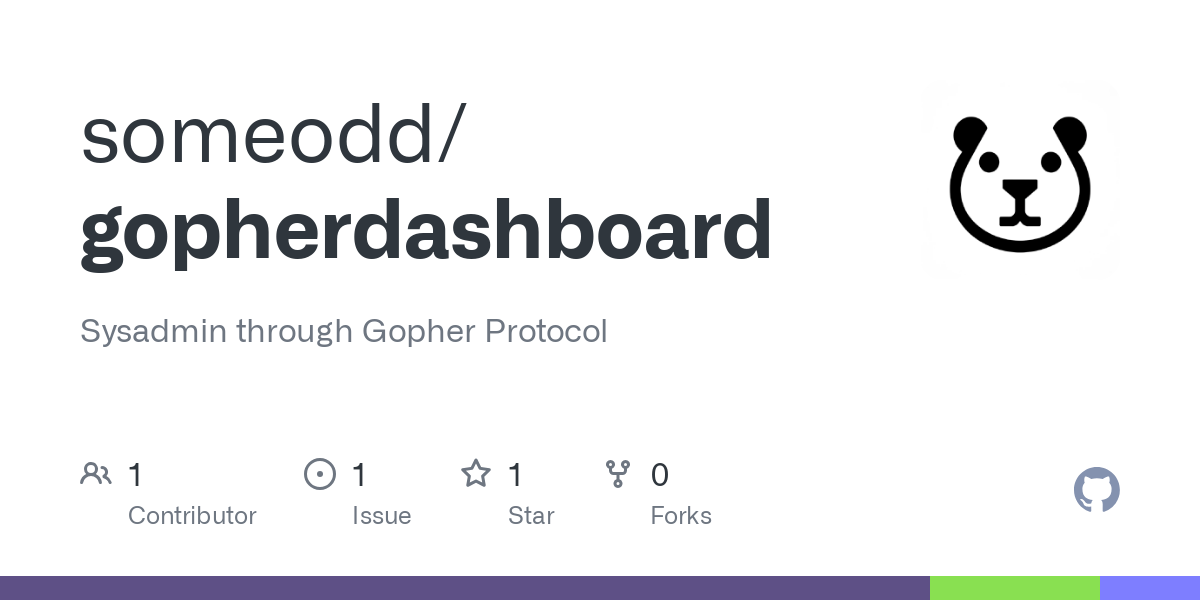#GopherProtocol
Can anyone recommend a GUI-based #GopherProtocol client?
In questa giungla stroboscopica che ti meraviglia, ti acceca e ti ipnotizza mi + venuta voglia di #gopher
https://it.wikipedia.org/wiki/Gopher_(informatica)
---
#gopherprotocol
Short #PSA on viewing my #gopherhole:
My gopherhole contains excessive Unicode characters (mainly emoji and braille art) and might be rendered as gibberish on other clients/proxies such as the Floodgap's Gopher proxy.
I added a warning on my gopherhole for new visitors.
Btw, I got my gopher site fully functional. Well, some oversights here and there but I finally figured out how to make gophermaps.
GophrtVR is a gopher client with it's 3D visualization tool for viewing resource collections as 3D scene. It's unic with it's 3D navigation if I dare to say among all kinds of browsers that I have seen. Although sadly it's in an uncompleted state there's e.g. the bookmarks functional witch if it clicked says "not implemented yet". But regardless of it's being alpha software and will stay in that state it's still fun to mess with it .
Kind of accidental #hypercard game engine written in #haskell on track to be released by #christmas.
I also have a bunch of Debian server "administration" Markdown files I made which may be helpful to others. I started going wild on prepping my server, which lead to this project: https://github.com/someodd/gopherdashboard (#gopherprotocol server dashboard).

You haven't felt the pain of RFC 7686 before you've tried to visit a #GopherProtocol site over #TOR... #curl, which otherwise supports #gopher, refuses to resolve the .onion even when going through the TOR SOCKS5 proxy.
Luckily my system's #netcat still doesn't implement RFC 7686, so I can use that to manually speak gopher...
You just need a sorted index (vip:sort<cr> or use the linux sort command or something), and then alphabetize your entries using a header
LikeThis
========
You can find out what I mean over here:
gopher://gopher.waynewerner.com/0/ideas/waynes-wiki.eml
(You'll need a modern browser like Lynx that can support the #GopherProtocol because #gopher is the best <3 )
Do you know about GopherVR?
https://en.wikipedia.org/wiki/GopherVR
I used #gopher back in the 1990s.
But there has been a gopher revival going on
I.e., gopher is used today!
I wonder how many in the new Gopher community are aware of #gopherVR ?
.
( #gopherHole #gopherProtocol #gopherverse )
( #virtualReality #VR )
H/T @atomicpoet
4/
I used #gopher back in the 1990s.
But there has been a gopher revival going on
I.e., gopher is used today!.
The new gopher community should be open to creating new line-type codes.
That is part of how the #gopherProtocol was future-proofed.
Creating new line-type codes is using gopher as intended by the specification writer(s).
3/
An excerpt from #IETF #RFC1436
( https://www.rfc-editor.org/rfc/rfc1436 )
“[…] This removes the need to be able to anticipate all future needs and hard-wire them in the basic Internet Gopher protocol; it keeps the basic protocol extremely simple. In spite of this simplicity, the scheme has the capability to expand and change with the times by adding an agreed upon type-character for a new service.”
2/
An excerpt from #IETF #RFC1436 specification
( https://www.rfc-editor.org/rfc/rfc1436 )
“The first character of each line in a [ #Gopher ] server-supplied directory listing indicates whether the item is a file (character '0'), a directory (character '1'), or a search (character '7'). This is the base set of item types in the Gopher protocol. It is desirable for clients to be able to use different services and speak different protocols […] as needs dictate […]”


